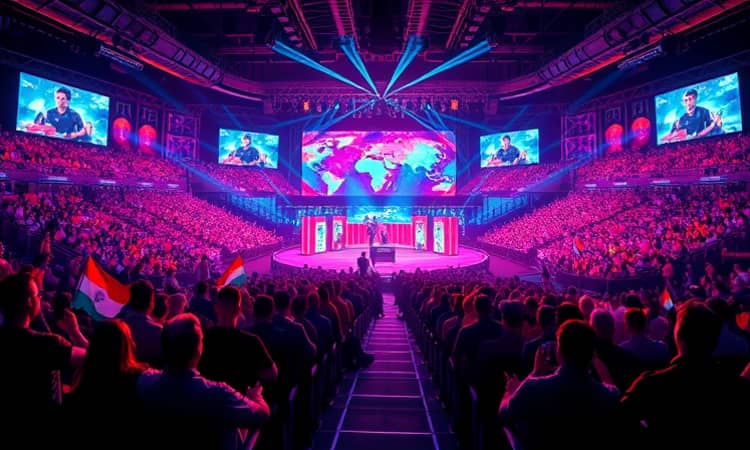From underground tournaments to packed stadiums, esports has transformed into a global phenomenon that transcends borders. This article unpacks the market dynamics, audience trends, and factors propelling this exhilarating industry.
Market Size and Growth Projections
The global esports market has experienced an extraordinary ascent, evolving into a multibillion‐dollar powerhouse. Valuations in 2024 hovered between USD 2.13 and 2.40 billion, driven by investments from major stakeholders and skyrocketing viewership.
Industry analysts forecast that this momentum will only intensify over the next decade. Projections vary, but they consistently highlight a remarkable compound annual growth rate that promises to redefine the entertainment landscape.
This table offers a snapshot of how conservative estimates align with more optimistic forecasts. Some reports predict a market surge to over USD 10.9 billion by 2032, while others envision an even steeper climb to USD 16.7 billion by 2033.
Audience and Viewership
Esports thrives on a dedicated and ever‐expanding fan base. Today, more than 540 million people globally tune in to watch competitive gaming, and by 2025 that number is set to exceed 640 million. Amateur and professional fans alike underscore the unprecedented scale of fan engagement that has become synonymous with modern esports.
- 640 million projected viewers by 2025
- 322.5 million occasional viewers and 318.1 million dedicated fans
- Asia Pacific accounts for over 57% of total viewership
- China and the Philippines contribute more than 40% of global fans
These figures reflect not only a quantitative leap but also the emergence of a vibrant culture around esports. Spectators gather online and in person, forging communities that celebrate strategy, skill, and camaraderie.
Revenue Streams and Business Models
Behind the roaring crowds and live streams lies a sophisticated web of monetization. Esports organizations, platforms, and publishers capitalize on diverse revenue sources to sustain growth and innovation.
- Advertisements through streaming platforms and in‐game placements
- Sponsorships and media rights revenue accounting for the bulk of earnings
- Consumer spending on tickets, merchandise, and digital goods
- Investments by game publishers fueling tournaments and prize pools
Average revenue per user (ARPU) has climbed to approximately USD 5.93, reflecting increased consumer spending and deeper engagement. As viewership scales, so too does the potential for new business models, from subscription services to exclusive content partnerships.
Key Growth Factors
Several catalysts have converged to propel esports from niche pastime to mainstream spectacle. Understanding these drivers illuminates how the industry can continue its upward trajectory.
- Increasing live streaming and platform accessibility
- Widespread availability of high-speed internet enabling real-time global matches
- Expanding investments in gaming infrastructure and tournaments
- Surge in mobile gaming popularity and cloud gaming adoption
- Attractive prize pools, with some events exceeding USD 30 million
- Strategic partnerships between developers and esports teams
- Post-pandemic audience growth fueled by online interaction
Each factor interlocks, creating a self-reinforcing ecosystem where fans, players, sponsors, and platforms all contribute to sustained expansion.
Professional Aspects and Monetization
Esports is now a legitimate career path. Top teams and players command staggering valuations and salaries, turning gaming passion into professional opportunity. Organizations like TSM boast valuations over USD 540 million, while elite players have earned upwards of USD 7 million in prize money alone.
Universities and colleges have recognized this shift, introducing dedicated programs to train the next generation of esports talent. From strategy analysis to performance psychology, these curricula aim to equip students with the skills needed to excel both on and off the virtual battlefield.
Business evolution within esports has been equally rapid. Ventures from media companies, venture capitalists, and Fortune 500 brands have poured resources into leagues, streaming platforms, and grassroots initiatives. This influx of capital has led to:
professional career choice among younger generations and a burgeoning industry that offers roles in coaching, shoutcasting, event management, marketing, and content creation.
Practical Steps for Aspiring Participants
For those inspired to enter the esports arena—whether as players, content creators, or industry professionals—actionable paths exist. Building a foundation of success involves dedication, skill development, and community engagement.
First, invest time in mastering specific games and understanding their competitive ecosystems. Consistent practice, constructive feedback, and participation in local or online tournaments sharpen abilities and build a competitive mindset.
Second, cultivate an online presence. Streaming on platforms like Twitch or YouTube fosters a direct connection with fans and potential sponsors. Quality content, authenticity, and regular interaction can accelerate growth and open doors to partnerships.
Third, network with industry insiders. Attend live events, join social media groups, and communicate with coaches, analysts, and veteran players. These relationships often lead to team tryouts, collaborative projects, and mentorship opportunities.
Finally, remain adaptable. The esports landscape evolves rapidly, with new titles, formats, and technologies emerging regularly. Embrace continuous learning, stay informed about industry trends, and be ready to pivot when fresh opportunities arise.
The Future of Esports
As we look ahead, the esports horizon is ablaze with possibilities. Emerging technologies such as virtual reality, augmented reality, and AI-driven analytics promise to revolutionize how competitions are played, viewed, and monetized.
A continued push for inclusivity and regional expansion will bring untold stories from underrepresented markets, enriching the global tapestry of esports culture. Additionally, deeper collaboration between traditional sports franchises and esports entities will blur the lines between physical and digital competition.
Ultimately, the sustained growth of esports rests on the passion of its community. From fans and players to organizers and investors, each stakeholder plays a part in shaping an industry that thrives on creativity, competition, and connection.
Conclusion
The journey of esports from niche hobby to global juggernaut offers valuable lessons in innovation, resilience, and community building. By understanding the market dynamics, audience trends, and driving forces behind this expansion, enthusiasts and professionals alike can harness the momentum to carve out their own success stories.
Whether you aspire to compete on the world stage, build a thriving content channel, or contribute to the business side of esports, the roadmap is clear: embrace the growth, engage with the community, and continually refine your craft. In doing so, you will not only witness the future of entertainment—you will help create it.
References
- https://www.statista.com/outlook/amo/esports/worldwide
- https://www.statista.com/topics/3121/esports-market/
- https://www.fortunebusinessinsights.com/esports-market-106820
- https://www.grandviewresearch.com/industry-analysis/esports-market
- https://scoop.market.us/esports-statistics/
- https://www.baker.edu/about/get-to-know-us/blog/exploring-esports-industry-opportunities-in-competitive-gaming/
- https://market.us/report/esports-market/














